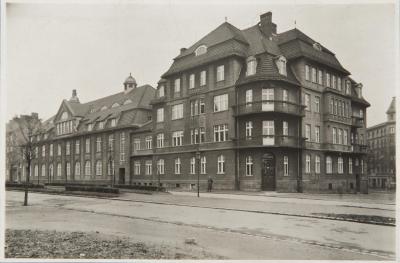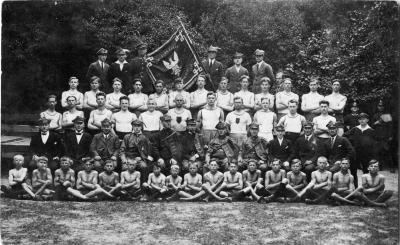The Polish grammar school in Marienwerder (Kwidzyń)

The Polish grammar school in Marienwerder (Kwidzyń) was set up in 1937 after many previous efforts to do so. Building began in 1934. The work was financed by the Slavic Bank in Berlin and completed in 1936. At the time it was one of the most modern school buildings in Eastern Prussia. The initiator of the project, Ernst Fechner, came from Olsztyn. The school building had various functions and contained a boarding school section and living quarters for the staff. The first director was Władysław Gębik. The school had a high level of learning. The usual courses were mixed with a patriotic Polish education. The school motto was “Non scholae, sed vitae discimus“ (We are not learning for school but for life). The school aimed to build a future Polish elite in Germany. All students were duty-bound to live in the boarding school independent of their home address. The teachers and other members of staff also lived in the school. Soon after it opened people began to call the school community the “Republic of Marienwerder”. The school even had its own hymn, the “Marienwerder Song”. In 1939 the Germans increased repressive measures against the school. On the 25th of August in the same year students and teachers were arrested and placed in a psychiatric institution in Gvardeysk (now in Kaliningrad Oblast). The youngest students were freed but the older students were enlisted into the army, whereas the teachers and other members of staff were imprisoned in concentration camps.
The education of young people was an important aim in the activities of Polish organisations in Germany. The usual educational duties were often tied in with a patriotic education. Only in this way was it possible to counter the Germanification of Polish young people and educate a Polish elite for a future in Germany. The supervision of education was the responsibility of the “Cooperative of Polish School Societies”(Związek Polskich Towarzystw w Niemczech). It was set up on 27th August 1922 at the same time as the “Union of Poles in Germany” (Związek Polaków w Niemczech) whose policies it implemented. The first elected chairman was the Berlin teacher Cezary Vogt. At the first General Assembly on 11th June 1923 the head of the Polish Catholic School Society in Warmia (Polsko-Katolickie Towarzystwo Szkolne na Warmię), Jan Baczewski, was elected as his successor. From the very start the society attempted to regulate the school system in Prussia. But it was not until December 1928 that the Prussian Council of Ministers decreed an “Order to Regulate the School System for the Polish minority”. This allowed, amongst other things, Poles to set up private schools in Germany. It was not an optimal solution. The schools had to be set up in autochthon areas, above all in Silesia, Warmia, Masuria and Pomerelia. The first private primary schools were set up in Opole in Silesia, and these were followed in other regions. There were a large number of problems entailed in setting up new schools. There were no suitable buildings, teachers were in short supply and schoolbooks a rarity. Furthermore the initiators were confronted at every step with harassment by Prussian civil servants, hostile German teachers, social discrimination and trickery. Any success in achieving their aims was entirely dependent on the determination of the parents.
Alongside primary schools attention was also paid to secondary schools. In 1932 people succeeded in setting up a “Polish-speaking Private Secondary School with a Grammar School Curriculum” in Bytom. Three years later this school was given public rights. 98 students entered the school in its first year of operation. In the final school year 181 students were enrolled in the grammar school.
A second private Polish grammar school was opened on the 5th November 1937 in Marienwerder in East Prussia. The selection of the location was no accident. Marienwerder was the second largest centre for Polish citizens in Germany. It took years of effort before it was possible to open the school. In 1934 a committee was set up to organise the construction of the grammar school in Marienwerder. The building was designed by the Olsztyn architect Ernst Fechner. His project, an example of modernist architecture united several functions and contained a boarding school section and accommodation for the staff. This was a highly modern solution. The school also had an assembly hall with curtains, lighting, a stage and cinema equipment. The students could follow sport lessons in a modern gymnasium equipped with showers. In addition there was an outside playing ground and a swimming bath. The school also had its own school radio.
All the building work and interior decorations were completed in 1936. However the German government deliberately delayed the opening of the school because it feared that a powerful educational unit would endanger its Germanification policies by educating a future Polish elite in Warmia and Masuria. Between 1934 and 1937 the “Union of Polish School Societies” was forced to to send over 100 reminders to the German authorities to allow the school in Marienwerder to be finally opened. The refusal of the German government to come to a decision was met with outrage by the Polish community. To put pressure on the Germans, the Pomeranian board of trustees in the school district decided to close the two largest and most popular German grammar schools in Bydgoszcz and Grudziądz at the start of the 1937/1938 school year. It did not have to wait long for the reaction it hoped for. On 31st October 1937 the president of the regional government, von Kendel, informed the “Union of Polish School Societies” that the Prussian Ministry for Schools had decided to allow the grammar school in Marienwerder to open. The school was officially opened on 10th November in the presence of the Chairman of the Union of Poles in Germany, Pastor Bolesław Domański. The official name of the school was the “Private School with a Secondary School Programme and Polish Teaching Language in Marienwerder”. The headteacher was Władysław Gębik, a biologist by profession. He was born in 1900 in Szczyrk near Limanowa and died in Kraków in 1986. He went to grammar school in the parish of Myślenice in Galicia and then followed a course in agriculture at the Jagiellonen University in Kraków. In 1920 he voluntarily enlisted in the Polish-Soviet war. He ended his studies in 1924 with the title of engineer. As well as working he continued his studies at the University in Poznan, and in 1928 was awarded a diploma as a secondary-school biology and chemistry teacher, before being awarded the title of Doctor of Philosophy in 1932.
There was a high level of teaching in the grammar school, which enrolled 94 boys in its first year. They followed the usual courses as well as having a Polish patriotic education. The staff consisted of 13 teachers of whom five were German citizens. The remainder were Polish citizens. Irrespective of where they lived all the students were duty-bound to live in the boarding school. The teachers and other members of staff also lived in the school. In this way the school aimed to perfect the independence of its students and build a sense of community. The school had its own hymn, the so-called “Marienwerder Song”. It began with the words: "Przeminęły już wieki a myśmy ostali, burzom dziejów nie dali się zgnieść" / “100 years have now gone by, but we have remained, do not let ourselves be crushed by the tempests of history”. The song was composed in March 1938 by a teacher named Leon Kauczor.
During the first two years of its existence the German government and the local population harassed the school with a number of dirty tricks, including intimidation measures and physical assault. In 1939 the Germans increased their repressive measures against the school. On 25th August of the same year the students and teachers were arrested and interned in a psychiatric institution in Gvardeysk (now in Kalingrad Oblast in the Russian Federation). All the students under 18 were released in the second half of September 1939, the older students were forcibly enlisted in the German army and the teachers and other members of staff imprisoned in the concentration camps in Stutthof, Mauthausen, Sachsenhausen and Gusen. Many of them did not survive the war. The grammar school was closed down. At the end of the Second World War the school was reopened in Marienwerder (Kwidzyń) which now lay within the borders of Poland. Today the traditions of the grammar school are continued in the “I. Allgemeine Lyzeum” in Marienwerder.
Krzysztof Ruchniewicz, June 2014


